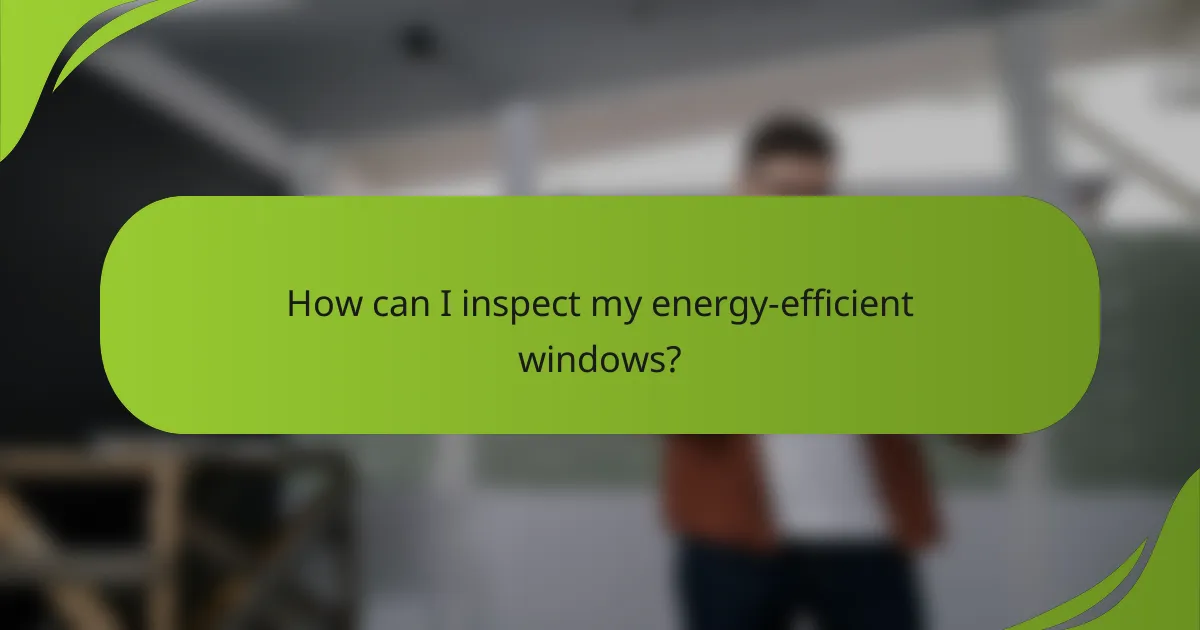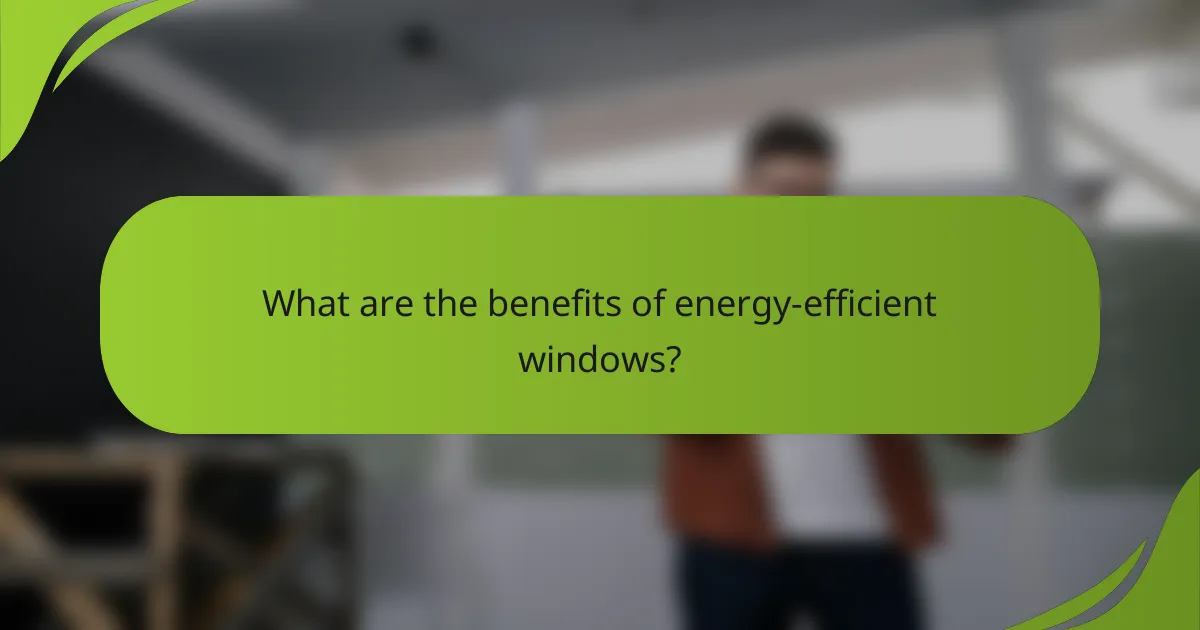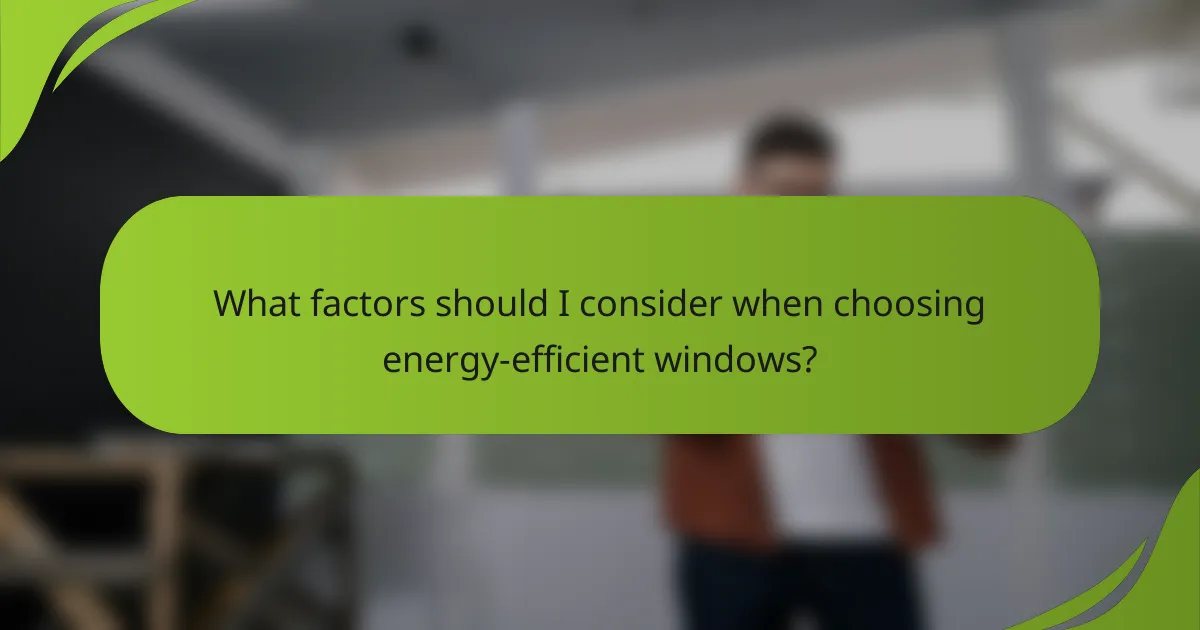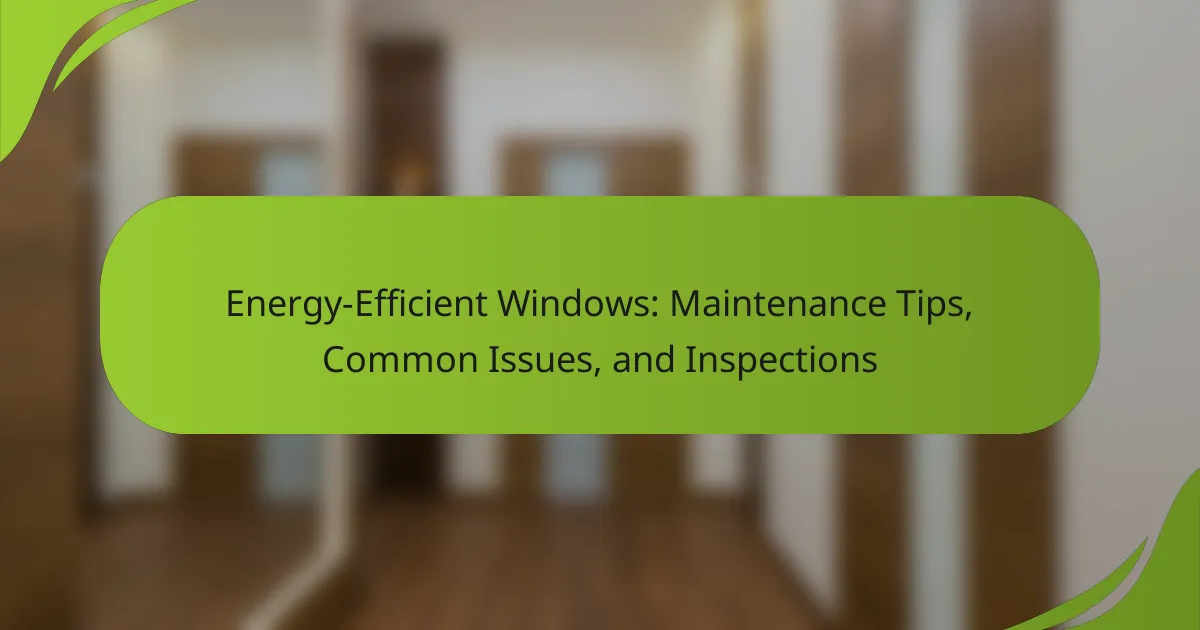Energy-efficient windows are essential for maintaining comfort and reducing energy costs in your home. To ensure their optimal performance, regular maintenance, including cleaning, checking seals, and conducting inspections, is crucial. Being aware of common issues can help you address problems early, prolonging the life of your windows and enhancing their energy-saving benefits.

What are the best maintenance tips for energy-efficient windows?
To maintain energy-efficient windows, focus on regular cleaning, checking weatherstripping, inspecting seals and frames, maintaining hardware, and conducting seasonal inspections. These practices help ensure optimal performance and longevity, ultimately contributing to energy savings.
Regular cleaning techniques
Cleaning energy-efficient windows is essential for maintaining their performance. Use a soft cloth or sponge with a mild detergent solution to avoid scratching the glass. Rinse thoroughly with water to remove any soap residue, and dry with a lint-free cloth to prevent streaks.
For hard-to-reach areas, consider using a squeegee or a window cleaning tool with an extendable handle. Avoid abrasive cleaners or tools, as they can damage the window’s surface and coatings.
Weatherstripping checks
Regularly inspect the weatherstripping around your windows to ensure a tight seal. Look for signs of wear, such as cracks or gaps, which can lead to drafts and energy loss. If you notice any damage, replace the weatherstripping promptly to maintain energy efficiency.
Common materials for weatherstripping include foam, vinyl, and rubber. Choose a type that suits your window style and climate for optimal performance.
Inspecting seals and frames
Check the seals and frames of your energy-efficient windows for any signs of deterioration. Look for moisture buildup between double or triple-pane glass, which indicates seal failure. If you find any issues, consider consulting a professional for repair or replacement.
Inspect the frame for cracks, peeling paint, or signs of rot, especially in wooden frames. Addressing these issues early can prevent more extensive damage and maintain the window’s energy efficiency.
Maintaining window hardware
Ensure that the hardware on your energy-efficient windows, such as locks and hinges, is functioning properly. Lubricate moving parts with a silicone-based lubricant to prevent sticking and wear. Regular maintenance of hardware helps ensure smooth operation and enhances security.
Check for rust or corrosion, particularly in coastal areas where salt air can accelerate wear. Replace any damaged hardware to maintain the integrity and performance of your windows.
Seasonal inspections
Conduct seasonal inspections of your energy-efficient windows to identify any potential issues. In spring and fall, examine the windows for dirt buildup, weatherstripping integrity, and any signs of damage. This proactive approach helps catch problems early and ensures your windows are ready for changing weather conditions.
Consider creating a checklist for your seasonal inspections, including tasks like cleaning, checking seals, and testing hardware. This will help you stay organized and ensure that no important maintenance tasks are overlooked.

What common issues affect energy-efficient windows?
Energy-efficient windows can face several common issues that impact their performance and effectiveness. Understanding these problems can help homeowners maintain their windows and ensure they continue to save energy and reduce costs.
Drafts and air leaks
Drafts and air leaks are prevalent issues that can significantly reduce the energy efficiency of windows. These leaks often occur around the window frame due to improper installation or wear and tear over time.
To identify drafts, conduct a simple test by holding a lit candle or incense stick near the window edges. If the flame flickers or the smoke moves, you likely have a leak. Sealing these gaps with weatherstripping or caulk can improve insulation and reduce energy costs.
Condensation problems
Condensation on windows can indicate poor insulation or humidity issues inside the home. When warm, moist air comes into contact with the cooler surface of the glass, it can lead to water buildup, which may damage the window frame and promote mold growth.
To mitigate condensation, ensure proper ventilation in your home, especially in areas like kitchens and bathrooms. Using dehumidifiers can also help maintain optimal indoor humidity levels, reducing the likelihood of condensation.
Frame warping
Frame warping occurs when the window frame is exposed to extreme temperatures or moisture, causing it to bend or twist. This can lead to gaps that allow air leaks and reduce the window’s overall efficiency.
Regular inspections can help detect early signs of warping. If you notice any distortion, consider replacing the frame or using materials that are less prone to warping, such as vinyl or fiberglass, which offer better durability in varying climates.
Glass breakage
Glass breakage is a serious issue that can compromise the energy efficiency of windows. It can occur due to impacts, temperature fluctuations, or manufacturing defects. Broken glass not only reduces insulation but also poses safety risks.
To prevent glass breakage, ensure that windows are properly installed and consider using tempered or laminated glass, which is more resistant to impacts. If a window does break, it is essential to replace it promptly to maintain energy efficiency and safety in your home.

How can I inspect my energy-efficient windows?
Inspecting your energy-efficient windows involves a thorough examination to ensure they are functioning correctly and maintaining energy efficiency. Regular inspections can help identify issues early, preventing costly repairs and improving comfort in your home.
Visual inspection checklist
Start by checking the window frames for any signs of damage, such as cracks or warping. Look for gaps between the window and the frame, which can indicate poor sealing and air leaks. Additionally, inspect the glass for condensation or fogging, as these can signal seal failure.
- Check for visible cracks or gaps in the frame.
- Look for signs of moisture or condensation between glass panes.
- Inspect weather stripping for wear or damage.
Tools needed for inspection
To effectively inspect your windows, you will need a few basic tools. A flashlight can help illuminate hard-to-see areas, while a moisture meter can detect hidden dampness. A level is useful for checking if the window is properly aligned.
- Flashlight
- Moisture meter
- Level
- Caulking gun (for repairs)
Signs of wear and tear
Common signs of wear and tear include drafts, difficulty opening or closing the windows, and visible damage to the frame or glass. If you notice increased energy bills, it may indicate that your windows are no longer performing efficiently.
Pay attention to any peeling paint or rust on metal frames, as these can lead to further deterioration. Regular maintenance, such as resealing and repainting, can extend the life of your windows and maintain their efficiency.

What are the benefits of energy-efficient windows?
Energy-efficient windows provide significant advantages, including reduced energy costs, enhanced comfort, and a positive environmental impact. By minimizing heat transfer, they help maintain a stable indoor temperature and lower utility bills.
Energy cost savings
One of the primary benefits of energy-efficient windows is the potential for energy cost savings. These windows can reduce heating and cooling expenses by a notable percentage, often ranging from 10% to 30%, depending on the climate and existing window type. Over time, this can lead to substantial savings on energy bills.
To maximize savings, consider windows with low U-factors and high Solar Heat Gain Coefficient (SHGC) ratings. These ratings indicate better insulation and reduced heat gain, contributing to lower energy consumption.
Improved comfort
Energy-efficient windows enhance indoor comfort by maintaining a consistent temperature throughout your home. They reduce drafts and cold spots, making living spaces more enjoyable year-round. This is particularly beneficial in regions with extreme temperatures.
Additionally, these windows can minimize glare and UV exposure, protecting furniture and flooring from fading. Choosing double or triple-pane windows can further improve comfort by providing better insulation against outside temperatures.
Environmental impact
Installing energy-efficient windows contributes to a lower carbon footprint by decreasing energy consumption. This reduction in energy use leads to fewer greenhouse gas emissions, supporting efforts to combat climate change.
Moreover, many energy-efficient windows are produced using sustainable materials and processes. By opting for these windows, homeowners can support environmentally responsible manufacturing practices while enjoying the benefits of reduced energy costs and improved comfort.

What factors should I consider when choosing energy-efficient windows?
When selecting energy-efficient windows, consider factors such as frame materials, glazing options, and local climate. Each of these elements significantly impacts the window’s thermal performance, durability, and overall energy savings.
Window frame materials
The choice of window frame material affects both energy efficiency and maintenance. Common materials include vinyl, wood, aluminum, and fiberglass, each offering different insulation properties and aesthetic appeal. For example, vinyl frames are often more affordable and provide good insulation, while wood frames offer a classic look but require more maintenance.
Consider the climate in your area when choosing frame materials. In regions with extreme temperatures, materials with better thermal performance, like fiberglass, may be more beneficial. Additionally, check for energy performance ratings, such as U-factor and R-value, to ensure you select a suitable option.
Glazing options
Glazing refers to the type of glass used in windows, which plays a crucial role in energy efficiency. Double or triple glazing, which consists of multiple panes of glass, can significantly reduce heat transfer compared to single-pane options. Low-emissivity (Low-E) coatings can further enhance performance by reflecting heat back into the room during winter and keeping it out during summer.
When considering glazing options, look for windows with a high Solar Heat Gain Coefficient (SHGC) if you live in a colder climate, as this allows sunlight to warm your home. Conversely, in warmer areas, choose windows with a lower SHGC to minimize cooling costs. Always check for certifications like ENERGY STAR to ensure compliance with energy efficiency standards.
